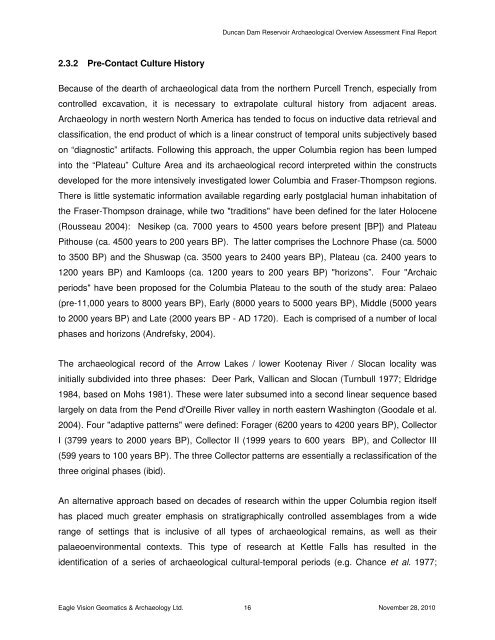November 2010 - BC Hydro
November 2010 - BC Hydro
November 2010 - BC Hydro
Create successful ePaper yourself
Turn your PDF publications into a flip-book with our unique Google optimized e-Paper software.
2.3.2 Pre-Contact Culture History<br />
Duncan Dam Reservoir Archaeological Overview Assessment Final Report<br />
Because of the dearth of archaeological data from the northern Purcell Trench, especially from<br />
controlled excavation, it is necessary to extrapolate cultural history from adjacent areas.<br />
Archaeology in north western North America has tended to focus on inductive data retrieval and<br />
classification, the end product of which is a linear construct of temporal units subjectively based<br />
on “diagnostic” artifacts. Following this approach, the upper Columbia region has been lumped<br />
into the “Plateau” Culture Area and its archaeological record interpreted within the constructs<br />
developed for the more intensively investigated lower Columbia and Fraser-Thompson regions.<br />
There is little systematic information available regarding early postglacial human inhabitation of<br />
the Fraser-Thompson drainage, while two "traditions" have been defined for the later Holocene<br />
(Rousseau 2004): Nesikep (ca. 7000 years to 4500 years before present [BP]) and Plateau<br />
Pithouse (ca. 4500 years to 200 years BP). The latter comprises the Lochnore Phase (ca. 5000<br />
to 3500 BP) and the Shuswap (ca. 3500 years to 2400 years BP), Plateau (ca. 2400 years to<br />
1200 years BP) and Kamloops (ca. 1200 years to 200 years BP) "horizons”. Four "Archaic<br />
periods" have been proposed for the Columbia Plateau to the south of the study area: Palaeo<br />
(pre-11,000 years to 8000 years BP), Early (8000 years to 5000 years BP), Middle (5000 years<br />
to 2000 years BP) and Late (2000 years BP - AD 1720). Each is comprised of a number of local<br />
phases and horizons (Andrefsky, 2004).<br />
The archaeological record of the Arrow Lakes / lower Kootenay River / Slocan locality was<br />
initially subdivided into three phases: Deer Park, Vallican and Slocan (Turnbull 1977; Eldridge<br />
1984, based on Mohs 1981). These were later subsumed into a second linear sequence based<br />
largely on data from the Pend d'Oreille River valley in north eastern Washington (Goodale et al.<br />
2004). Four "adaptive patterns" were defined: Forager (6200 years to 4200 years BP), Collector<br />
I (3799 years to 2000 years BP), Collector II (1999 years to 600 years BP), and Collector III<br />
(599 years to 100 years BP). The three Collector patterns are essentially a reclassification of the<br />
three original phases (ibid).<br />
An alternative approach based on decades of research within the upper Columbia region itself<br />
has placed much greater emphasis on stratigraphically controlled assemblages from a wide<br />
range of settings that is inclusive of all types of archaeological remains, as well as their<br />
palaeoenvironmental contexts. This type of research at Kettle Falls has resulted in the<br />
identification of a series of archaeological cultural-temporal periods (e.g. Chance et al. 1977;<br />
Eagle Vision Geomatics & Archaeology Ltd. 16 <strong>November</strong> 28, <strong>2010</strong>

















